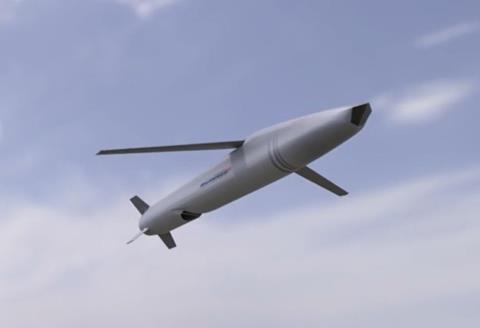General Atomics Electromagnetic Systems (GA-EMS) and Rafael will partner on a new long-range precision-guided strike missile called Bullseye.
A memorandum of understanding between the two companies sees GA-EMS become the prime contractor for the weapon, which can be deployed from air, ground, and sea platforms.

GA-EMS says that the weapon will provide “strike mass at an affordable price point”.
“We are excited to work with Rafael to introduce Bullseye, a highly effective deep-strike missile,” says GA-EMS president Scott Forney.
“Bullseye will be built in the US for delivery to US military customers to support a variety of critical Department of Defense and coalition partners’ precision-fires missions.”
The weapon is at Technology Readiness Level 8, says GA-EMS, which means that the technology in the weapon has been proven. GA-EMS indicates that the weapon’s maturity greatly reduces risks.
Rafael has already performed a range of tests focused on the weapon’s aerodynamics, engine, seeker, and launch integration.
“Additional testing is being scheduled for flight qualification and to prove operational readiness with missiles on order and scheduled for delivery starting late 2025 and onwards,” says GA-EMS.
Bullseye appears to be based on Rafael’s Sea/Ice Breaker weapon. A Bullseye promotional video on the General Atomics website closely resembles the Ice Breaker video on Rafael’s website.
First unveiled at the Singapore air show in February 2024, the Sea/Ice Breaker has an air-breathing engine and an unclassified range of 162nm (300km).
The weapon weighs 400kg (882lb) and carries a 113kg warhead. Four can be carried by a Lockheed Martin F-16, and two can be carried internally by the Lockheed F-35.
In Singapore, a Rafael spokesman said that the Sea/Ice Breaker is “not a concept, but a programme of record”. At that time Rafael had signed up two customers for the weapon, with orders of a “significant quantity”.
Guidance is provided through an electro-optical/infrared sensor in the nose, and the weapon is designed to operate in GPS-denied conditions.
Although the weapon operates autonomously, it has a satellite connection back to the pilot of the launching aircraft, who can intervene if necessary. The satellite connection also helps the weapon transmit information for battle damage assessment purposes.
Four or more Sea/Ice Breakers can be teamed up to simultaneously attack a target, with the weapons using a datalink to communicate among themselves.
GENERAL ATOMICS IMPROVES MQ-9B TARGETING CAPABILITY
General Atomics Aeronautical Systems (GA-ASI) has demonstrated software that provides in-flight target updates from the MQ-9B SeaGuardian unmanned air vehicle to a missile via the Link 16 datalink.
The software has been validated in a lab and will be tested in a live-fire demonstration this year.
“We continue to build on the innovative capabilities of SeaGuardian for the US Navy,” says GA-ASI president David R. Alexander.
“The targeting we’ve demonstrated will be especially valuable in contested environments, enabling an unmanned asset like SeaGuardian to be used for higher-risk missions instead of putting manned assets at risk.”


























